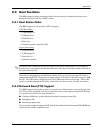
Technical Reference Guide www.hp.com 8-7
System BIOS
8.4.1 System ID and ROM Type
Diagnostic applications can use the INT 15, AX=E800h BIOS function to identify the type of
system. This function will return the system ID in the BX register. Systems have the following
IDs and ROM family types:
The ROM family and version numbers can be verified with the Setup utility or the System Insight
Manager or Diagnostics applications.
8.4.2 Temperature Status
The BIOS includes a function (INT15, AX=E816h) to retrieve the status of a system's interior
temperature. This function allows an application to check whether the temperature situation is at
a Normal, Caution, or Critical condition.
8.5 SMBIOS Support
These systems support SMBIOS version 2.6. and usethe table-based method of accessing
SMBIOS data. SMBIOS structures can be located by looking in the EFI Configuration Table for
SMBIOS_TABLE_GUID and using the associated pointer. Refer to the SMBIOS 2.6
specification for more information on accessing SMBIOS data.
✎
System information on these systems is handled exclusively through the SMBIOS.
8.6 USB Legacy Support
The system BIOS ROM checks the USB port, during POST, for the presence of a USB keyboard.
This allows a system with only a USB keyboard to be used during ROM-based setup and also on
a system with an OS that does not include a USB driver.
On such a system a keystroke will generate an SMI and the SMI handler will retrieve the data
from the device and convert it to PS/2 data. The data will be passed to the keyboard controller
and processed as in the PS/2 interface. Changing the delay and/or typematic rate of a USB
keyboard though BIOS function INT 16 is not supported.
Table 8-3
System ID Numbers
System (Form Factor) System ID BIOS Family
USDT 1496h J01
SFF 1495h J01
MT 1497h J01
CMT 1494h J01


















